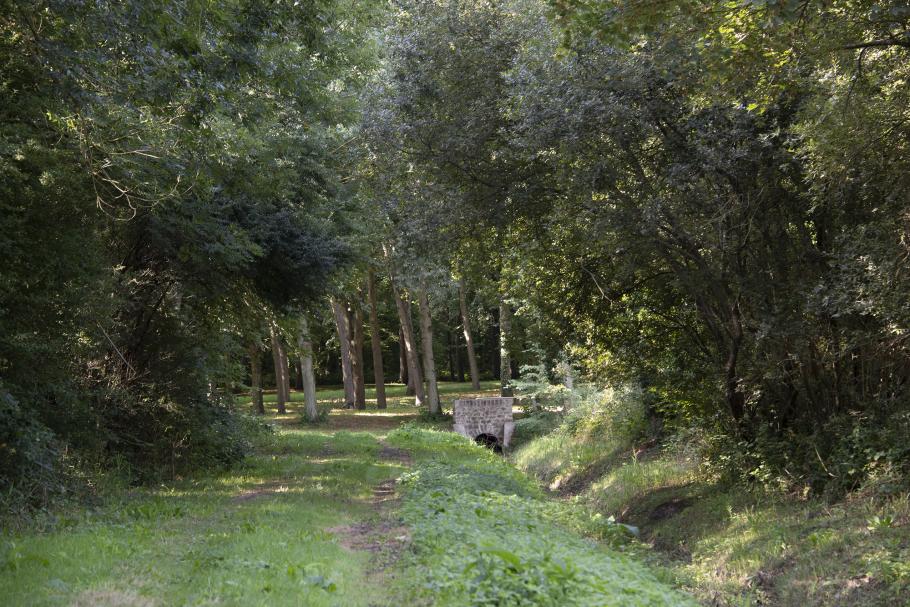The stream of the Ru de Gally runs from its source in the Grand Canal and across part of the Park, revealing the incredible biodiversity of the Estate of Versailles.
The Ru de Gally Stream

Regular visitors to the Park at Versailles are familiar with the watercourse known as the Ru de Gally. It flows out of the Grand Canal, where the water level is regulated by the Estate’s fountain engineers, and runs west for 22 kilometres (including 2 km within the Estate), towards the Gally plain, supporting myriad biotopes along its entire length.
 Locate it on the interactive map
Locate it on the interactive map
The Palace of Versailles is keen to preserve this biodiversity and showcase its rich variety, and is therefore inviting visitors to take a walk between the Grand Canal and the gardens of the Grand Trianon, and wind their way alongside this modest watercourse – which can sometimes dry up in summer. The route will take them through four different zones identified by the gardeners at the Estate of Trianon, where they can spot frogs, dragonflies, butterflies and even birds of prey, while being entertained by a chorus of birdsong from the likes of robins, goldfinches and warblers. Alders, silver willows and other signature trees of the riverbank, meanwhile, provide welcome shade. In spring, the banks are festooned with water irises, whose shape resembles that of the royal emblem – the fleur-de-lys.

The managed high forest
This area, to the west of the northern branch of the Grand Canal, is where the Ru de Gally rises. This pleasant wood with trees of various species and ages, features a range of spaces and is home to several species of animal. The dead trees preserved by the gardeners provide food, shelter and protection for the animals. In particular, they accommodate nesting boxes for passerine species of bird, such as tits, finches and nuthatches. The woodpiles provide shelter for small mammals, such as hedgehogs, and a source of food for the wood-eating insects at the bottom of the food chain.
The glade
Here, the dense forest gives way to the light. The sun manages to reach the level of the undergrowth, enabling shrubs to grow. The resulting hawthorn and euonymus are a food source for the surrounding fauna. The open spaces are conducive to the flourishing of butterflies, like the Cabbage White or “large white” butterfly, and the Meadow Brown, which is very common in the Park of Versailles.
The presence of the stream is good for the black alder – that stalwart of the riverbank, with its heart-shaped leaves. Amphibians live in the water during the tadpole or larval stages, before relocating to the humid areas on the surface once they reach adulthood. They hibernate in the earth or beneath tree trunks and reappear in spring.
The reed bed and wetland
This zone, known as a megaphorb community in landscape ecology, is a transitional space between the forest and the wetland. The fork in the Ru de Gally actually leads to an artificial pond created by the Estate gardeners and fountain engineers to keep the stream running during the dry season and attract wildlife. It is particularly popular with dragonflies – such as the yellow or blue orthetrum – which need water in which to lay their eggs, and with frogs, who suffer more from dehydration than toads. The plant life has adapted to the environment, with the formation of a reed bed, for example, which is a whole ecosystem in itself. Then there are the beautiful white willows, with their slender trunks and spear-shaped leaves. Finally, the water irises, which grow naturally in the beds of slower-moving watercourses. The particular shape of the flower, with its four petals, resembles the fleur-de-lys – the symbol of the French monarchy.
The undergrowth
This is a cool and humid zone with dense groves on both sides of the stream, which is spanned by three small culverts. These allow small animals to cross and complete the biological corridor formed by these successive environments.
The stream runs off the Estate of Versailles to the north of the Royal Star and joins the Mauldre river 20 kilometres downstream.
Practical information
The Ru de Gally is located in the Park, with its source in the Grand Canal, close to the Horseshoe Pool, in the extension of the north branch of the Canal.
Locate the Ru de Gally on the map
You can reach it on foot or by bike by entering the Estate through the Queen’s Gate or the Saint Anthony Gate. Access via the gardens is for pedestrians only.
If you are coming by car, you can park on the Place D’Armes at the Grand Trianon.
The Park is open every and entry is free.

Show
The Musical Fountains Show and the Musical Gardens
From April 1 to October 31 2025, enjoy the Musical Gardens and the Musical Fountains Show in the gardens and groves opened for the occasion. Every Saturday evening from 7 June to 20 September, discover the Gardens in the evening with the The Night Fountains Show.

Patronage
Restoration of the Queen’s Grove
After two years of works, the Queen’s Grove is now open to the public. Several patrons, from France and overseas, companies, foundations and institutions, as well as a hundred of private individuals have supported this exceptional restoration.










